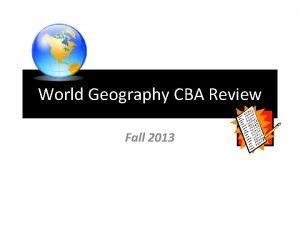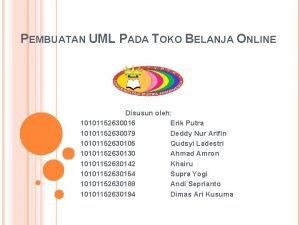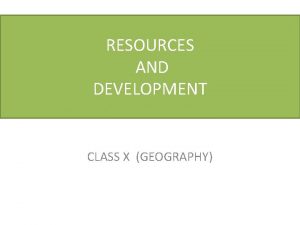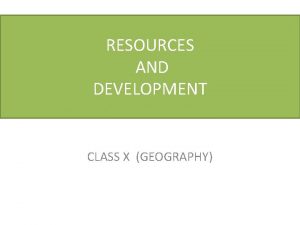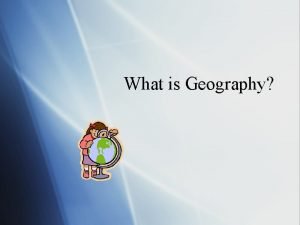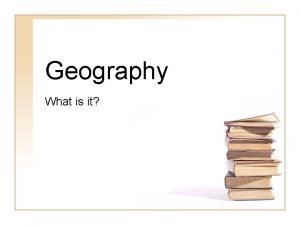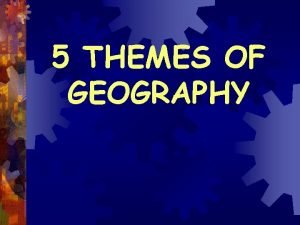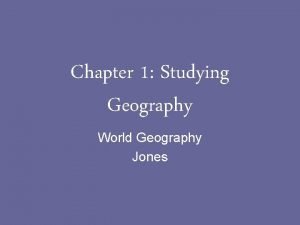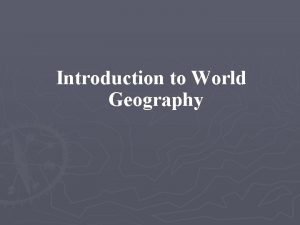GEOGRAPHY Online class CLASS 12 Session 2021 22











- Slides: 11

GEOGRAPHY Online class CLASS 12 Session: 2021 -22 ©Mahadevi Birla Shishu Vihar

FORMAT OF ISC BOARD QUESTION PAPER Full Marks: 70 � � � � � Time: 3 Hrs Part I (All must be attempted: 30 Marks) Question 1: Short questions from entire syllabus: 20 M (2 X 10) Question 2: Map pointing: 10 M (1 X 10) Part II (Any 4 questions to be attempted: 40 M) Question 3: Entire 1 st unit: Locational settings of India, Geological evolution and structure, Relief, Drainage, Climate, Natural Vegetation. (10 M) ……. . (1 st preference) Question 4: Entire 2 nd unit: Population, Migration Trends, Demographic attributes, Rural settlements, Urban settlements. (10 M)……. (2 nd Preference) Question 5: Environmental management and land use pattern, Water resources and types of irrigation. (10 M)……. (3 rd Preference) Question 6: Agriculture, Fisheries, Minerals and power resources. (10 M)…… (Avoid) Question 7: Transport and communication. (10 M)……. (4 th Preference) Question 8: Industry , Tourism industry. (10 M)……. (Avoid) Question 9: Regional economic development. (10 M). …. . (Additional

Chapter 1: Locational setting of India 1. Extent and Position of India (Lat &Long, Area, Boundaries) Learning Modules 2. Locational advantages of India in the Indian Ocean and as a subcontinent 3. Comparison: China and Australia üWe will learn the sub topics with the help of map so that you can have the idea of map pointing as well. ü The topic is described in points for your better understanding and also you can have an idea how to write the answer as per the board criteria. .

1. Extent and Position of India 0 Longitude India is located in the NE hemisphere of the earth Tropic of Cancer, 23 30 N Latitude Equator, 0 Latitude 82 30 E Longitude Important facts about India • Location of India: 8 4 N to 37 6 N Latitude 68 7 E to 97 25 ELongitude • Continent: Asia • The Tropic of Cancer, 23 30 N Lat. Is passing through the middle of India. • The northern most point of India: Indira col • The southern most point of India: Indira point in the south of Nicobar island • The southern most point of the main land India: Kanyakumari • Total area: 32, 87, 263 sq. Km (2. 4% of the total geographical area of the whole world) • India shares its longest boundary with Bangladesh and shortest boundary with Afganistan • India measures 3, 214 km from north to south and 2, 933 km from east to west. It has a land frontier of 15, 200 km. • India has the longest coastlines of 7, 517 km if the coastlines of Andaman and Nicobar islands as well as of the Lakshadweep islands are added.

India with its neighbouring countries N. B. • While drawing the eastern most and western most longitudes, you must touch the eastern most and western most points of India. • Tropic of Cancer will be semicircular whereas ISM will be a straight line.

Sub-topics � SUBCONTINENT: A landmass, that is a part of a continent but is considered either geographically or politically as an independent entity. � INDIA IS KNOWN AS A SUBCONTINENT: Three reasons: Ø Ø Ø � � Vastness: India extends from 8 4 N to 37 6 N Latitude and 68 7 E to 97 25 E Longitude. (MUST MENTION THE LAT. & LONG. ) It has varieties of physical features from lofty Himalays to Oceans, from Thar desert to wettest place of the world. India is an abode of different religions, cuisines, climates, cultures and races. It is a part of a continent (Asia) but is different from the continent and is separated by a physical barrier. It has got all the features of a continent but is only a part of the continent. ARUNACHAL PRADESH EXPERIENCES SUNRISE 2 HRS. EARLIER THAN SOURASHTRA: The longitudinal difference between Sourashtra in the west and Arunachal Pradesh in the east is about 30 . Since there is a difference of 4 mins at every 1 , threfore the time difference for 30 will be (30 X 4) = 120 mins = 2 hs. But the watches show the same time everywhere because we follow the local time of the Indian Standard Meridian (82 30 E ) which is passing through Mirzapur, near Allahabad.

‘INDIA IS NEITHER PIGMY NOR A GIANT AMONG THE NATIONS OF THE WORLD’ – JUSTIFY : There are six countries bigger than India. Russia is five and a half time bigger than India, Canada, China and USA are about three times bigger than India. As against this, India is 4 time bigger than France, 9 times bigger than Germany and 23 times bigger than Bangladesh. THE IMPORTANCE OF INDIA’S LOCATION: India stands at the head of the Indian ocean at the very center of the Eastern Hemisphere commanding trade routes running all directions. Its location, size and economic resources have made it the most dominating country among the littoral states. * Littoral States: The states who share boundaries with water bodies. Indian Ocean is the only ocean in the world which has been named after a country. The Indian ocean has never been a barrier between the countries. It has always served as a great linkage between the countries lying on its coasts and even further beyond. The Trans Indian ocean routs connects the developed countries of Europe in the west and the developing countries of Asia in the East through Indian coastlines. Also it is easier to connect West Asia, Africa and Europe from the western coasts and south east Asia and Oceania from the eastern coasts.

� THE INDIAN OCEAN IS TRULY INDIAN OCEAN : � � India stands at the head of the Indian ocean. The Indian ocean bridges the gap between east and west. The peninsular tableland of India juts into the Indian ocean for a distance of 1600 km. No other country has such a long coastline in this ocean as India has. � ‘INDIA IS JEWEL IN THE CROWN’ – JUSTIFY: � The centrality and the consequent significance of India has contributed a lot in the geopolitics and economics of the country. The highly profitable oceanic trade structure attracted the west Asian Muslims and the European colonial powers towards India. During the British period, India was known as ‘jewel of the crown’ due to its wealth and because of its role as a fulcrum upon which the imperial and commercial system in Asia was balanced. � � � ‘INDIA IS KNOWN AS THE MISTRESS OF THE EASTERN SEA’ – JUSTIFY: � India commands an important strategic position on the globe with respect to trade as well as social and cultural interaction. India’s major contacts with outside world for the last two millennium have been by sea. In the ancient days, the boats of the Babylonians and the Egyptians used to sail in � �

74 E 54 N 135 E 18 N Ø 3 rd Largest country in the world. Ø Total area: 95. 97 lakh sq. km. Ø Three time bigger than India Ø It shares its long southern boarder with India, Nepal, Bhutan Ø As compared to India, the latitudinal extent of China isn’t much but Ø The longitudinal extent is more than double the longitudinal extent of India. CHINA Neighbouring countries of China

114 E AUSTRALIA 10 S Tropic of Capricorn 44 S 154 E 23 30 S Neighbouring countries & oceans of Australia Ø 6 th largest country in the world. ØIsland country (Because it is surrounded by oceans from all the sides). ØThe only country in the world which occupies the entire continent by itself. Ø Total area: 76. 86 lakh sq. km. Ø More than double times bigger than India. Ø Tropic of Capricorn passes through the middle of Australia. Ø As compared to India, the north-south extent of Australia is almost equal to India but the east-west extension of Australia is over 1000 km than that of the India. ØThe latitudinal extent of both India and Australia is almost same. But the longitudinal extent is 30% more than the longitudinal extent of India.

THANK YOU ALL! Presented by Mrs. Subhra Biswas
 2021-2022 q1 9 week world geography cba
2021-2022 q1 9 week world geography cba Telpas training
Telpas training Ap human geography frq format
Ap human geography frq format 5 themes of geography ap human geography
5 themes of geography ap human geography Ap human geography political geography test
Ap human geography political geography test Wasilla high school schedule
Wasilla high school schedule Class of 2021
Class of 2021 Welcome to city guesser
Welcome to city guesser Class diagram penjualan online
Class diagram penjualan online Course registration tool
Course registration tool Prayer on online class
Prayer on online class Welcome to my online class
Welcome to my online class
